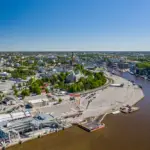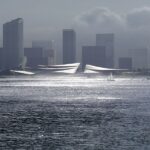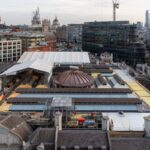Dublins Parlour Design Competition, Dublin Building, Project, Contest News
Parlour Design Competition Dublin : Contest
Development Proposal by LiD Architecture in Dublin, Ireland
4 Feb 2010
Parlour Design Competition
Dublin’s Parlour : Design Proposal
The Strategy
The proposal aims to form a connection between the Docklands Development, Point Village and the energy of Dublin Port. The shipping container, symbol of global trade and exchange, is utilized as a building element to solve all the pragmatic and design issues of the brief, as well as opening up further possibilities and appropriations.
The context of Dublin the Port City is heightened by the strategic positioning of elements in the square that are visible on an urban scale. An atmosphere of high energy, excitement and creativity is generated in the square by the range of activities that can be facilitated there, both day and night. Play of sunlight and shadows by day transforms into a dynamic lighting effect by night so that each visit to the square will be memorable.
Why Containers?
“There are redundant containers all around the world (most notably in Europe and North America), due to the imbalance in manufactured goods between the West and the Far East, where the majority of the world’s goods are produced. The West imports more than it exports and the imported goods travel in containers… It is often more economical to buy a new container in China than to send the used one on the return journey. As a result the worlds ports are piled up with empty containers.” Jure Kotnik: Container Architecture
Our proposal uses 116no. 6m, and 7no. 12m, and 2no. 3m containers. The use of containers relates to the working port and references the history of the O2 Venue as a distribution depot. The robust aesthetic conveys the unique condition of a site on the threshold of city and working port – The Parlour becomes both an edge and a transition from the Docklands to the port beyond.
The design celebrates the temporary nature of the Parlour project. Easy to assemble, disassemble, transport, and re-use, as well as being locally sourced from container holding companies at the port, the shipping container in this context is the ideal sustainable building element.
Inhabited Screen
Containers are easily stacked to form a permeable and stable screen. Furthermore, their depth and enclosure allows them to become an “inhabited screen” to give a life and a dynamic edge to the square. Thus, programme can be integrated into the screen e.g. Lighting, and Lighting/ Sound Control Box, Back of Stage, Restaurant Seating Areas, Market Stalls, and Kiosks.
The screens are permeable to pedestrians from all sides and yet can also facilitate the closing off of the square for specific events. The proposal allows a flexible arrangement of locations for entry and exit points depending on the nature of the event or usage of the square. Stairs integrated into the screen on all four corners for the square make all parts of the screens easily accessible for lighting/ maintenance and other uses. The existing tarmac surface is to be retained in the proposal as it is considered to fit with the urban aesthetic of the containers.
Other Programmes
The ground level containers can be used as kiosks or market stalls, with side panels opening up to form canopies. These will contain basic service points for power and water supply allowing potential for many varied uses – fishmongers, night markets, exhibitions, D.J. gigs, etc. The possibility exists for further inhabitation of the screen beyond the scope of the competition brief. For example a continuous viewing gallery at upper levels could be used for watching events, and could also have a daytime life as a linear semi-outdoor art gallery.
Lighting
During the day the checkerboard pattern of the screen creates a changing pattern of shadows and light across the square. At night, the containers provide the lighting concept, each acting as an urban-scale light fitting, resulting in a lighting atmosphere of unique and specific character.
This is achieved by painting the interiors of the containers white and housing two bars of programmable colour-changing LED lights. These can change colour and intensity and can be programmed as part of a concert or performance event. This is done from the “Lighting and Sound Control Container”, located in the west screen facing the stage and housing a basic digital interface that allows compatibility with touring light and sound specialists. In the stage screen (east), the illuminated container ends provide a digital lighting façade, allowing figurative lighting displays and effects. For example, basic numerals can be created in lighting, allowing a new year’s count-down.
Lighting trusses are integrated into the projecting containers overlooking the stage to facilitate stage lighting. Additional concert lighting can also be easily attached to the surrounding container screen, without the need for additional cranes or scaffolding.
For practical and safety purposes, the interior and exterior of the square would be well illuminated by these container lighting walls and the IBC containers mentioned below.
Fire
To offer a contextual interpretation of the centralised fire suggested in the brief, illuminated recycled Intermediate Bulk Containers (IBCs) are stacked on either side of the stairwells to the car parking and under-ground bar. In this way, they provide a centralised light feature, integrate the stairwells into the square, and provide a memorable entrance to the square when arriving from the car park or bar.
The 1000l cuboid drums can be ballasted with water for stability and are often stacked in this way to form temporary outdoor event spaces (examples in Barcelona and the Netherlands). An LED lighting detail (using DecaLED Flex RGB) has been devised to illuminate the drums uniformly from within, and again, these lights can be controlled as part of an overall lighting display or sequence.
Illuminated IBC cubes are also used along the “spine building” to guide pedestrians from the quay to the square.
Back of Stage
The back-of-stage areas are easily incorporated into the containers underneath and to the sides of the stage area. Thus ancillary services do not disrupt the visual drama of the west elevation. This façade has been designed to be a highly visible colourful and permeable edge to the square.
Stage and Stage Roof
The stage is constructed simply of 5no. 12m containers, which project out from the screen to achieve maximum sight lines. The stage is partially covered with the “container roof” which spans over the stage, integrating it with the screen.
This roof provides shelter to the stage as well as housing the 10.24m x 7.66m motorized screen for open-air cinema and other events. The roof is accessible from the two sides of the stage via stairs and can house lighting, drop-down props etc. for specific performances (e.g. circus acrobatics, pantomime). If required, a simple canopy-type roof could also be incorporated into the front of the container roof to shelter the projecting stage area.
Café Treatment and Seating Areas
Restaurant outdoor areas are incorporated into the overall spatial composition by running a series of containers along the restaurant seating edge. They function either as sheltered canopies for seating or can be used by the cafes as outdoor serveries or BBQ areas. Allowing the cafés to bring their serving points directly into the square, e.g. on a summers day or for a specific event, helps to activate the seating area and enlivens the square.
Viewing Tower / Landmark
In the northeast corner of the site, one bay of containers is stacked to a height of 22.5m to form a viewing platform. This tower would be visible from the quays, East Wall road and from the Mayor Street axis. Illuminated at night, the tower provides a visual point of reference, from the port and from the city centre, accentuating its position of threshold between port and city. Its visual prominence allows it to act as signage announcing events occurring in the square.
The tower contains a stair, which offers the potential for a spectacular viewing point overlooking the port as well as panoramic views back towards the city along the Luas spine. Inside the viewing tower, information about Dublin Port could be displayed. Discussions with the Dublin Port Company’s P.R. Department indicate that they are keen to promote public awareness and interest in the port. They!welcome the idea of a public viewing point over the port that could be a potential tourist attraction for the 1.3 million tourists arriving to the port each year on cruise vessels.
Structure
The container arrangements in the proposal are based on existing precedents of container architecture and we have had the scheme reviewed and approved by a Structural Engineer for this submission.
The advantage of the container system structurally is that they lock together to form an interlocking structural unit. They are lightweight and the ground level container will distribute the load evenly onto a stable ground plane.
The staggered positioning of the containers provides lateral structural stability, whilst the checkerboard permeability means that wind- loading is reduced. On the east screen, wind permeability is achieved with the use of open-ended containers. Where fixings between containers are required, predominately in the elevation above 3-storey in height, a standard cable system can be utilised to provide adequate stability.
In some areas, for example the viewing tower where the containers are stacked 9-high, a minimal steel support frame can be attached and fixed back into the ground. For the stage roof, containers effectively fixed together can span across the stage. Containers allow a high structure to be built without the need for foundations and the structural elements required will not interfere with the re-usability of the container units.
Re-Cycling – Demount-ability – Re-Usability
The inherent advantage of containers is that they are readily available and inexpensive. They can be used largely in their “as found” condition, with some minor adjustments – painting, removing doors, installing lighting, etc. The use of containers allows an abundant and locally found resource to be recycled in an innovative way.
This re-use extends to the life of the containers beyond the life span of the square. The containers can be returned to use as transport and storage units, or the entire square can be easily dismounted and re-constructed in another location. In this sense, the proposed design registers the reality of the economic downturn, but celebrates the possibilities of re-using and recycling as a response.
Dublins Parlour Design Competition images / information from LiD Architecture
Location: Dublin
Dublin Architecture
Dublin Parlour Competition : main page
Dublin Buildings

image © make architects
Comments / photos for the Parlour Design Competition – Dublin Architecture Contest page welcome




